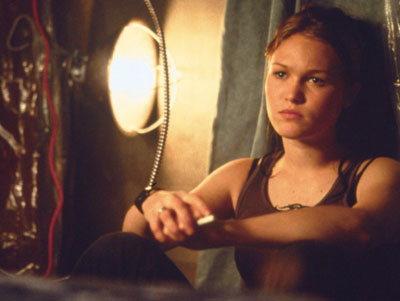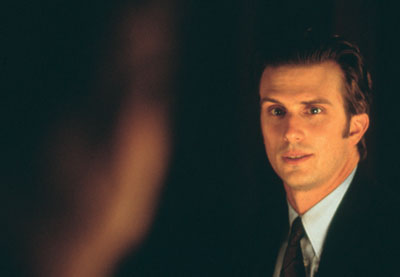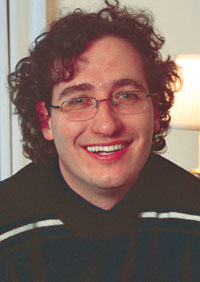POWER POINT
Set in a functional universe of corporate meeting rooms, airport lounges and business hotels, Patrick Stettner’s The Business of Strangers looks at female relationships in a man’s world. Peter Bowen speaks to writer/director Stettner.
 |
| Stockard Channing. Photos: Jojo Whilden. |
From Theodore Dreiser to Erin Brockovich, the fate of the working woman holds a dear place in the American imagination – even though most screen fiction has been intent on turning working women into working girls. Patrick Stettner’s debut feature, The Business of Strangers updates the tale of the working woman to reflect the complex architecture of class and international corporate capitalism that structures her identity.
Architecture is a key term for Stettner, who sets his drama meticulously in the streamlined biospheres of airport terminals and corporate hotels. In concert with this minimalist architecture, he has created a tightly drawn drama of two women coming to terms with the masculine world that has shaped their own feminine identities.
When a business presentation by a high-powered, ball-busting executive Julie Styron (Stockard Channing), is ruined by tardy technical assistant Paula Murphy (Julia Stiles), the boss takes no time in dressing down and dismissing the poor girl. Later, having returned to the airport hotel, Styron discovers that she has been unexpectedly promoted to CEO. Celebrating, Styron discovers Murphy stuck at the hotel bar and, as a form of apology, invites her to enjoy the luxury of her corporate expense account. But the ensuing "girls night out" shifts gears dramatically when Murphy identifies Styron’s corporate headhunter as the man who date-raped a friend back in Boston. The result is a postmodern psychodramatic spin on the rape-revenge film, as Styron and Murphy peel apart the layers of their own identities as they take revenge on their seemingly horrible victim.
For Stettner the film poses two challenges. First, he wants to realize as completely as possible the inner lives of two women caught up in corporate culture. Second, he wants to identify the structure of the worlds – corporate, gendered, class-specific and architectural – that contain and define them.
 |
| Julia Stiles. |
FILMMAKER: The Business of Strangers focuses specifically on women in business. What was your initial fascination with that subject?
PATRICK STETTNER: Business women in films have always been these stereotyped women screaming on the phone. We do have that in the film. But here you also see more of their lives. I was a temp for a couple of years, and I was really interested in that world. I myself come from an artistic background. My father is a photographer, and my mother was in the diplomatic field. It was a new world for me, a world with its own strange rules.
FILMMAKER: There’s something obviously perverse in treating the world of everyday business as exotic. You have created a world where anyone would think twice about going into airport hotels.
STETTNER: They are creepy places. People in airport hotels have a completely different context, or lack thereof, than [ those staying at] regular hotels in cities. There’s the sense that they’re playing with house money. That they can do whatever they like because they’re not going to be there the next day.
FILMMAKER: What sort of research into airport hotels did you do?
STETTNER: I visited every hotel in a 100-mile radius of New York City. When I was taking my short film around, I always wanted to stay in airport hotels. I loved the weird sense of being an island in this industrial landscape. They have their own massive air systems, and some have these tropical gardens. In the film, re-creating that feel was definitely something the designer and I were working on. We made one room the desert room, one the tropical room, one the lagoon. It was a design issue that isn’t obvious, but we wanted to evoke a sense that these characters are trapped. Visually, we began working with a wide-angle lens, gradually moving to longer lenses, since it was really important to see the characters in these rarified spaces.
FILMMAKER: The hotel becomes an eco-system.
STETTNER: We also played with that idea in the sound mix. Birds are suddenly heard, or running water for no reason is suddenly heard inside.
FILMMAKER: The film concerns itself with the architecture of alienation, opening and ending with that space, but the heart of the film takes place in claustrophobic rooms of the hotel, including one in a wing that is undergoing renovation.
 |
| Fred Weller. |
STETTNER: I wanted to start with the façade of the building, but as the characters got within each other’s characters, we also get into the bones of the building. We talked about that in design meetings: "Let’s start seeing girders and wires and plastic." I wanted to end in a more primal place.
FILMMAKER: The film starts to border on science fiction.
STETTNER: In what sense?
FILMMAKER: There’s a way that buildings become organic creatures. There’s a vein of science fiction, where the machines begin to resemble creatures and act as such. Here the hotel airport manufactures within its own eco-system an internal and artificial nature. In many ways, the film imagines the building as having internal organs.
STETTNER: We did actually consider the hotel as a distinct character. There’s that sense that where the characters are going in their relationship mirrors where they are going in the building. But in the end, I wanted the focus to be on the characters. We’re not trying to capture the boardroom world. You know, I always get offended by having the film compared to In The Company of Men. The [films take place in] two very different realms. It is like saying all westerns are the same – that Blazing Saddles is like The Searchers.
FILMMAKER: Ken Loach once distinguished his work from American films by claiming that American cinema never really confronts the fact that people spend most of their time at work.
STETTNER: This isn’t completely devoid of that, but ultimately I wanted most to follow the logic of the characters.
FILMMAKER: How did you develop the characters? Were they based on people you really knew?
STETTNER: They was based on characters at these jobs I worked at when I was a temp. These different lawyers and ad people that I was under who had been in the business world for some 20 years and were considered to be established and high ranked. I was fascinated by their lives.
FILMMAKER: But you don’t really see their lives in the film.
 |
| Patrick Stettner. Photo: Richard Kern. |
STETTNER: A large part of their lives is spent in hotel rooms! And that goes back to my fascination with the world of airports and airport hotels.
FILMMAKER: How did your fascination with women in business become the germ for a script?
STETTNER: I had written three scripts before I did this one and I’d spent a long time with another one but was never very happy with it. One of the great things about doing short films is being able to control all of the elements. I was really afraid of doing a feature where it was just too much to handle, especially in a low-budget sort of way. I wanted to make something that would have a unified look, where the acting, tone, mise-en-scene and set design all matched. There were scripts I was trying to write that I was never really happy with. And there were scripts I was happy with which were really too big.
FILMMAKER: When you were writing the film, were there models for the relationship between the two women, both in their complicity and competition?
STETTNER: In terms of the issues of power, I was really thinking of Polanski. For architectural reasons, I was really into Todd Haynes’s Safe, and at the same time Erick Zonca’s The Dream life of Angels. For both, there’s a depth to the characters and a freshness of structure. I never felt like I knew where those films were going.
FILMMAKER: In writing the script, how did you craft the sense of dramatic surprise?
STETTNER: My process is that I write out the script and then I tear it apart, taking out the conventions, taking out the things you think are going to happen, while trying to stay true to the character. I always want my characters thinking two steps ahead, so you always get the idea you’re catching up to them.
FILMMAKER: Part of the film’s surprises seem to come from the fact that the spaces you create are highly theatrical. Anybody can be who they say they are, and your plot ultimately depends on that.
STETTNER: These characters, in some way, have no past. They have no context, so they’re allowed to do things you wouldn’t expect.
FILMMAKER: Recently there have been quite a few works that have reflected this level of non-contextualized consumerism. Fight Club is a prime example, but there was recently the novel Up in the Air.
STETTNER: Yes, more and more of our lives are lived in this global village. But I want to make this distinction: While the design element was important in the creation of the story, the drama depends on the characters. I didn’t want this to be a formal exercise where you weren’t emotionally attached to these characters. I didn’t want it to be this cool film that nobody relates to. In Deauville, one critic labeled me a subversive humanist – creating work that is challenging on a formal level but which also addresses characters. I never want to leave that base.
FILMMAKER: How do you marry the two –the concept of this postcapitalist, consumer culture with the emotional reality of two people’s lives?
STETTNER: It is a fine line between how much the background becomes present. I wanted the background present, but not to the point that everyone could look at the tableau and not be involved. I want to engage people in a very fundamental way with these characters.
FILMMAKER: That seems to link you to the work of your executive producers [Scott McGehee and David Siegel who directed The Deep End] and their interest in melodrama. Except in this case, you’re dealing with two women who could easily have been drawn as cartoons. How do you keep melodrama from falling into satire?
STETTNER: I made it clear that the film is about the characters. At points, you add levels to make the film richer, but you can’t include these other levels at the cost of losing touch with the characters.
FILMMAKER: In making this film, you worked with a series of producers. How did that evolve?
STETTNER: First there was Susan Stover. We had worked together on my thesis film, Flux. That film was one of her first producing gigs, when she was changing careers from being a lawyer. Then at the Sundance Screenwriters Lab, I met Scott and David.
FILMMAKER: What was the aesthetic that bonded you?
STETTNER: We shared a vision of what independent film could be – something within a limited budget that makes you think and has good characters, and that isn’t a romantic comedy.
FILMMAKER: Are you trying to say that the Business of Strangers is not a romantic comedy?
STETTNER: [laughs] It might be.
FILMMAKER How quickly after meeting did you go into production.
STETTNER We met in the January Screenwriters Lab, and then after the director’s lab in July, they were ready to go, and we started the casting process. Our first priority was the Julie character – once we got that cast we could better judge who could be the younger woman. I’d sent the script to Stockard, and she expressed an interest. I went out to meet her in Arizonza. Once she said yes, the task of finding the Paula character actually became even harder. Stockard has a lot of strength, and you couldn’t just put any younger actress up against her. I’d see these young actresses, and I’d be terrified that Stockard would sink her teeth into them. They were just so young. But Julia struck me as very strong. She has always been very mature for her age. She did this film when she was 19.
FILMMAKER How did they work out – especially since your first film depends on the chemistry between two characters?
STETTNER: They got along great. I think Stockard spent a lot of time in the hotel room watching a lot of MTV with Julia. Julia would explain who the different artists were.
FILMMAKER The difference in their ages seems to identify the recent history of feminism. One comes out of ’70s’ feminism, and one articulates a postfeminism stance that’s not down with the "Sisterhood is Powerful" cult.
STETTNER: The Stockard character is definitely one of these trailblazing women who made her way in a male-dominated world. There’s definitely a class element in the film. Paula comes from a sense of entitlement, and the Julie character comes from a working-class background and has always had to prove herself. And there’s a sense that Paula’s ability to do a lot of what she does comes from a confidence that she can always go home to her folks.
VOD CALENDAR


 See the VOD Calendar →
See the VOD Calendar →


